click image for larger view
The inbound marketing explosion [infographic]
Seattle: Most Indicators Positive
 Tech and aerospace industries keep Seattle and surrounding cities competitive with the rest of the nation. Based on data compiled by the Seattle Market Review (March 2012), the Evergreen State shows economic growth with several bright spots.
Tech and aerospace industries keep Seattle and surrounding cities competitive with the rest of the nation. Based on data compiled by the Seattle Market Review (March 2012), the Evergreen State shows economic growth with several bright spots.
-
Seattle ranks in the top three for tech startup jobs around the nation, according to PayScale’s “Tech Startup Hotspot Score.” PayScale takes into account median annual pay and availability of new positions. Only San Francisco and Austin beat out the Emerald City, which enjoyed a median salary of $74,900.
-
Boeing is seeing its highest levels of employment since 1999, when 82,400 men and women were employed, according to the News Tribune. At the end of February, the company employed 82,325 workers in Washington and a total of 171,921. The majority of jobs were added in WA, the center of the company’s commercial airplane production and design work.
-
Seattle’s unemployment rate fell to 7.5 percent in January, down from 7.7 percent in the month prior. Overall in the state, unemployment dropped to 8.3 percent.
What does the labor market growth mean for housing? King County’s inventory is shrinking. Fewer homes were listed for sale in February than at any time since the housing crisis started. And while the U.S. median single-family sale price fell by 2 percent in February — to $308,125 — Seattle has fared better. Its median house price went up by 3 percent to $365,000 from February 2011.
28 Ways to Customize Your Kitchen for Less
1. Zinc-top prep table: Use a potting bench to stand in for an island; its shelf can hold pots for cooking just as easily as ones for planting. Finish it to match your cabinets, or use an accent color to make it a focal point. One we like: Living Accents bench, about $240; Ace Hardware
2. Warm wood counters: Gentle on knives and simple to install yourself, butcher block is one of the most popular—and affordable—countertop materials. Choose long, edge-grain strips or blocky end grain. A ½-inch-thick-by-26-inch-square beech slab, about $29; Ikea
3. Skirted sink: A curtain on a $7 rod handily hides cleaning supplies and plumbing and adds a welcome hit of color and pattern. Buy a fabric remnant and stitch it yourself or have a tailor sew it to your specs. Find designer prints for under $10 per yard; Joyce Fabrics
4. Pendants with patina: Repro lights can cost more than the real deals. You pay for new wiring and the ease of not having to troll salvage yards. But these days many dealers refurbish their old lights, and the search is half the fun. Find ready-to-install vintage industrial pendants like these, about $100 to $225; Portland Architectural Salvage
5. Metal backsplash: A nod to commercial kitchen backsplashes, galvanized-steel roofing forms a fire-safe barrier between the range and the wall. Make yours using Galvalume Ribbed Steel Roof Panels, about $32 per 38-by-144-inch piece; Lowes
6. Stylish score: A hanging plate rack doubles as a dramatic window treatment. Get a similar one, about $130; Plow & Hearth
Read the rest here at ThisOldHouse.com
Market Tracker: February Existing-Home Sales Up Strongly from a Year Ago
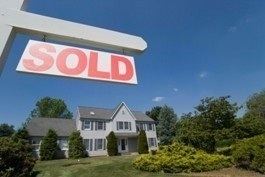 February existing-home sales declined from an upwardly revised January pace but are well above a year ago, while the median price posted a slight gain, according to the National Association of REALTORS®. Sales were up in the Midwest and South, offset by declines in the Northeast and West.
February existing-home sales declined from an upwardly revised January pace but are well above a year ago, while the median price posted a slight gain, according to the National Association of REALTORS®. Sales were up in the Midwest and South, offset by declines in the Northeast and West.
Total existing-home sales, which are completed transactions that include single-family homes, townhomes, condominiums and co-ops, slipped 0.9 percent to a seasonally adjusted annual rate of 4.59 million in February from an upwardly revised 4.63 million in January, but are 8.8 percent higher than the 4.22 million-unit level in February 2011.
Lawrence Yun, NAR chief economist, says underlying factors are much better compared to one year ago. “The market is trending up unevenly, with record high consumer buying power and sustained job gains giving buyers the confidence they need to get into the market,” he says. “Although relatively unusual, there will be rising demand for both rental space and homeownership this year. The great suppression in household formation during the past four years was unsustainable, and a pent-up demand could burst forth from the improving economy.”
According to Freddie Mac, the national average commitment rate for a 30-year, conventional, fixed-rate mortgage was a record low 3.89 percent in February, down from 3.92 percent in January; the rate was 4.95 percent in February 2011; recordkeeping began in 1971.
NAR President Moe Veissi says market conditions are improving. “Supply and demand have become more balanced in more markets, but with tight supply in the lower price ranges—particularly in the West,” he says. “When markets are balanced, we normally see prices rise one to two percentage points above the rate of inflation, but foreclosures and short sales are holding back median prices.”
The national median existing-home price for all housing types was $156,600 in February, up 0.3 percent from February 2011. Distressed homes—foreclosures and short sales sold at deep discounts—accounted for 34 percent of February sales (20 percent were foreclosures and 14 percent were short sales), down from 35 percent in January and 39 percent in February 2011.
“The bottom line is investors and first-time buyers are competing for bargain-priced properties in much of the country, with home prices showing signs of stabilizing in many areas,” Veissi says. “People realize that homeownership is an investment in their future. Given an apparent over-correction in most areas, over the long term home prices have nowhere to go but up.”
Total housing inventory at the end of February rose 4.3 percent to 2.43 million existing homes available for sale, which represents a 6.4-month supply4 at the current sales pace, up from a 6.0-month supply in January. Even so, unsold listed inventory has trended down from a record 4.04 million in July 2007, and is 19.3 percent below a year ago.
“Falling visible and shadow inventory, combined with a dearth of new-home and apartment construction during the past three years, assure that rents will continue to rise, with likely home price increases in 2012,” Yun says.
Fifty-one percent of NAR members report that contracts settled on time in February, 18 percent had delays and 31 percent experienced contract failures; the cancellation rate was 33 percent in January and 9 percent in February 2011. Contract failures are commonly caused by declined mortgage applications and failures in loan underwriting from appraisals coming in below the negotiated price.
“Many buyers are staying in the market after experiencing a contract failure and making an offer on another property, showing their determination to take advantage of the favorable conditions, but the cancellations are contributing to an uneven sales pattern,” Yun says.
All-cash sales rose to 33 percent of transactions in February from 31 percent in January; they were 33 percent in February 2011. Investors account for the bulk of cash transactions.
Investors purchased 23 percent of homes in February, unchanged from January; they were 20 percent in February 2011. First-time buyers accounted for 32 percent of transactions in February, down from 33 percent in January and 34 percent in February 2011.
Single-family home sales declined 1.0 percent to a seasonally adjusted annual rate of 4.06 million in February from 4.10 million in January, but are 9.4 percent higher than the 3.71 million-unit level a year ago. The median existing single-family home price was $157,100 in February, which is 0.1 percent above February 2011.
Existing condominium and co-op sales were unchanged at a seasonally adjusted annual rate of 530,000 in February and are 3.9 percent above the 510,000-unit pace in February 2011. The median existing condo price was $153,000 in February, up 1.6 percent from a year ago.
Regionally, existing-home sales in the Northeast fell 3.3 percent to an annual level of 580,000 in February but are 5.5 percent above a year ago. The median price in the Northeast was $225,800, down 1.9 percent from February 2011.
Existing-home sales in the Midwest rose 1.0 percent in February to a pace of 1.02 million and are 13.3 percent higher than February 2011. The median price in the Midwest was $120,500, which is 0.5 percent below a year ago.
In the South, existing-home sales increased 0.6 percent to an annual level of 1.77 million in February and are 9.3 percent higher than a year ago. The median price in the South was $138,100, up 1.8 percent from February 2011.
Existing-home sales in the West declined 3.2 percent to an annual pace of 1.22 million in February but are 6.1 percent above February 2011. The median price in the West was $195,300, up 3.1 percent from a year ago.
For more information, visit www.REALTOR.org
Efficient Light Bulbs: Green Design Will Save the World
 Energy-sucking 60-watt incandescent light bulbs are still found in homes around the world, however there a variety of light bulbs out there that last longer, consume less energy, and provide up to 95% of the light output. Considering the fact that incandescent bulbs will be phased out in the near future (January 2014, to be exact), it’s time to consider replacing them with efficient alternatives. Hit the jump for an infographic explaining the different energy-efficient lighting solutions out there!
Energy-sucking 60-watt incandescent light bulbs are still found in homes around the world, however there a variety of light bulbs out there that last longer, consume less energy, and provide up to 95% of the light output. Considering the fact that incandescent bulbs will be phased out in the near future (January 2014, to be exact), it’s time to consider replacing them with efficient alternatives. Hit the jump for an infographic explaining the different energy-efficient lighting solutions out there!
Concrete Cubist Home: Modern Monolith in the City
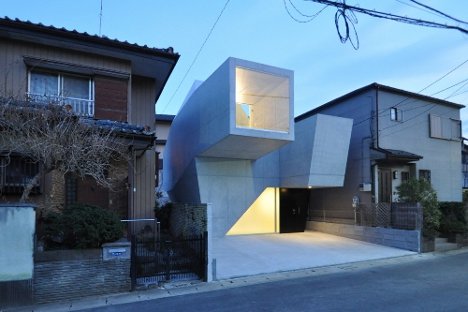
Among the traditional houses and run-of-the-mill apartment towers in Abiko, Japan sits a concrete monolith. Its angular facade is reminiscent of a massive sculpture, but this unusual object is actually a single-family home.
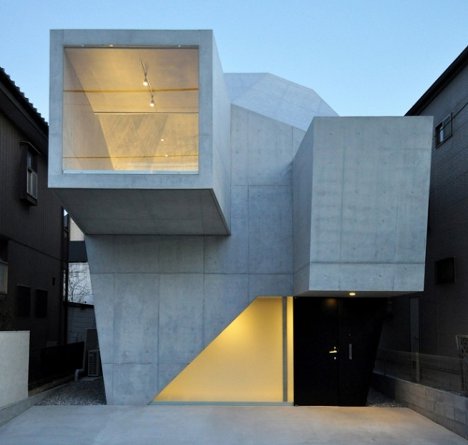
Designed by Fuse-Atelier, the Abiko House is a mere 80 square meters. The home sits on soft ground that necessitated the use of stakes to support its weight.
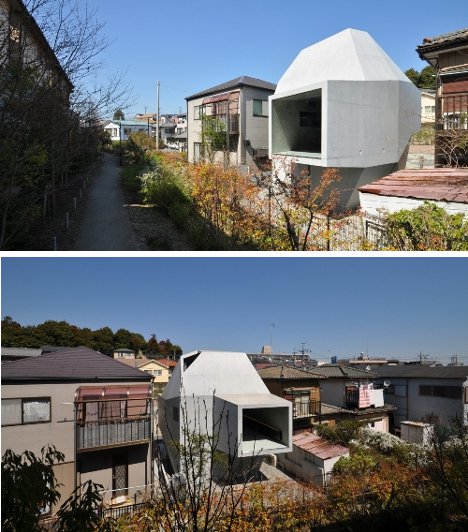
The residents of the impressive home wanted a distinctive building that was bathed in natural light on the inside. This is achieved partially with the massive window on the front protrusion.
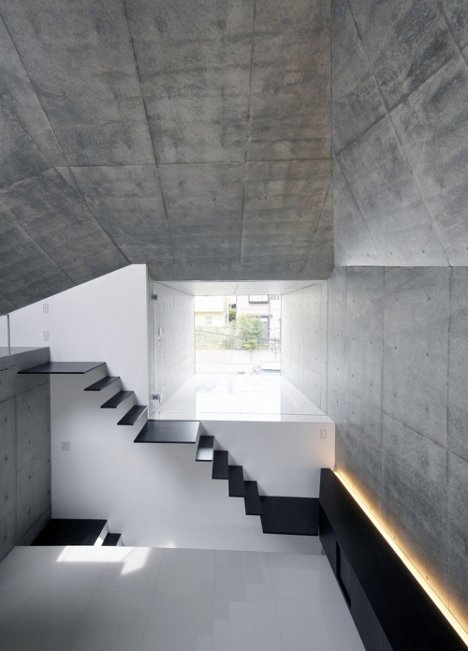
This protrusion houses the living and dining rooms which are accessible via a floating staircase. Although this is the type of staircase you wouldn’t want small children to use, it reinforces the airy, open feeling of the home’s interior.

Soaring above the streets, the home somewhat resembles a gigantic concrete periscope. The large front window is at such a height and position that neighbors and passers-by are prevented from seeing in.
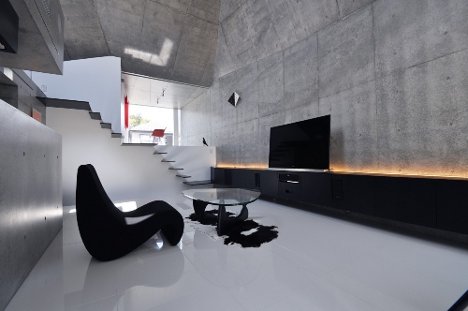
The heaviness of the concrete that comprises the home is perfectly offset by the home’s airy minimalist interior. But we have to imagine the echoes and dampness that would plague a cavernous concrete house might drive the residents to distraction.
Curved Cliff House: Metal & Glass Bend in Waterfront Breeze
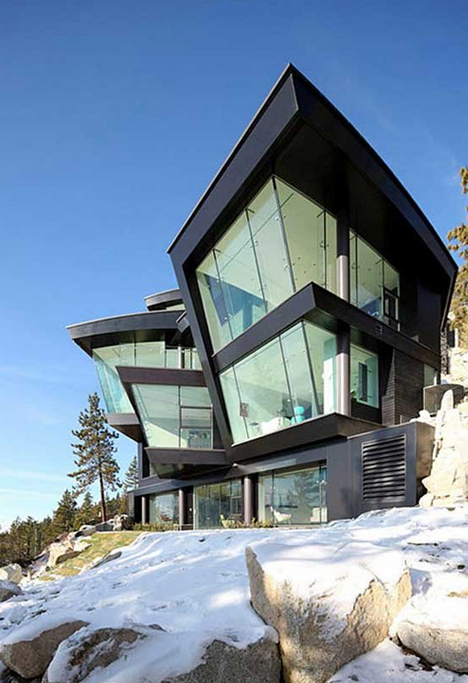
Its exterior shape is more than just an affection, though at first glance it almost looks to have been formed by natural elements – waterfront wind and waves.
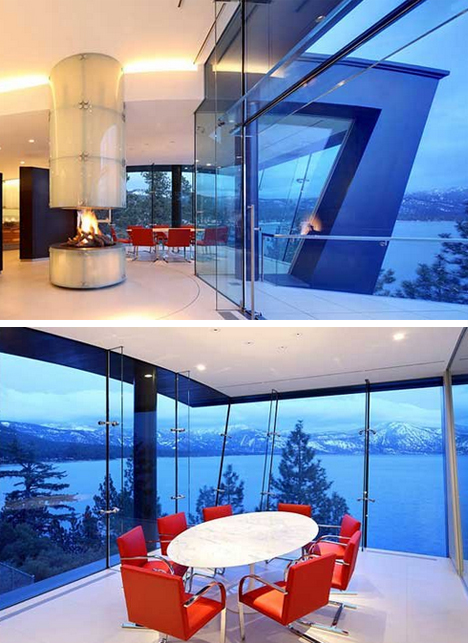
However, these contortions translate into a series of spaces where convex and concave moments of glass inform remarkable views back out of this Lake Tahoe retreat by Mark Dziewulski Architect.
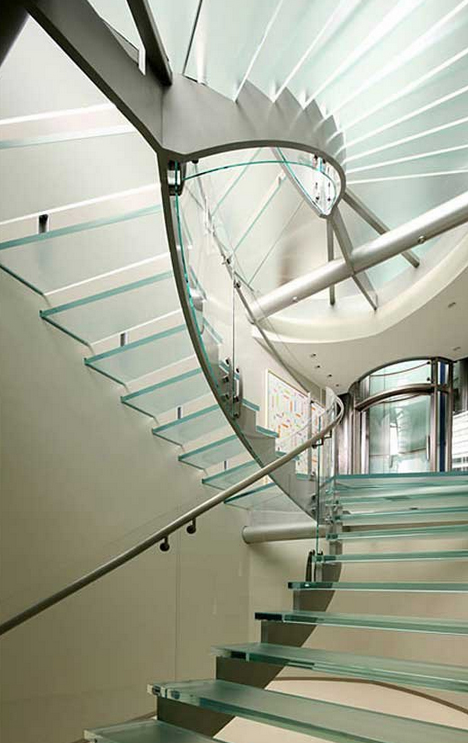
A stunning tapered oval glass staircase wraps up a central tower, dynamically depositing residence on different floors facing different ways back out onto the natural landscape.

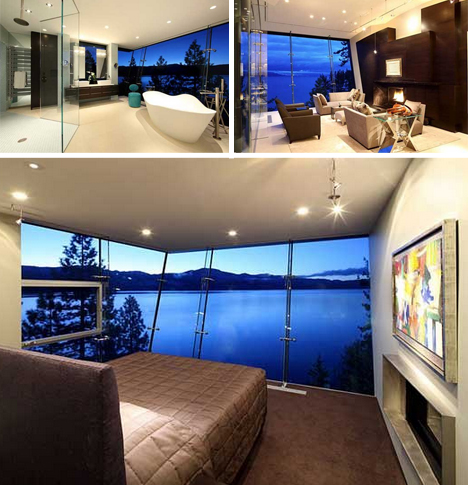
Strategic overhangs in individual spaces provide daunting experiences in places like the bedroom, but a corresponding feeling of connection with the outdoors (as well as shade from the high and hot summer sun).
Housing Market Reaches Turning Point, Economists Say
 Economists say the housing market is starting to heal, but too many people aren’t aware of it because they’re judging a housing recovery on the wrong sign: What’s happening with home prices.
Economists say the housing market is starting to heal, but too many people aren’t aware of it because they’re judging a housing recovery on the wrong sign: What’s happening with home prices.
Paul Dales at Capital Economics says higher prices won’t be the sign that the housing market is on the mend — that can be a lagging indicator — but rather an increase in overall home sales. And that’s showing signs of improvement: Existing home sales in 2011 rose to 4.26 million compared to 4.19 million in 2010. In the last six months alone, home sales have increased 13 percent.
As a recent article at Fortune points out, “The evidence reminds us that perhaps we should change our expectations of what a housing recovery might look like, particularly following a crisis marked by record foreclosures and a financial crisis that sent the economy into one of the deepest recessions. The recovery we have been anticipating is defined more on the rate at which the glut of vacant properties comes off the market as opposed to any steady rise in prices, which some think won’t happen for another few years.”
Source: “The One Number to Watch for a Housing Recovery,” Fortune (March 20, 2012)
Mountain Home’s Infinity Pool is a Nature Lover’s Paradise

This home in Stockholm, designed and built by DAPstockholm, is a study in the enjoyment of nature from a man-made structure. Called the Villa Midgard, the lovely three-story house has been set into the surrounding inclining landscape.

The stand-out feature is an infinity pool reminiscent of a serene forest lake. Clad in dark concrete and sheltered by the stable mass of the home itself, the pool offers residents a quiet, protected place to be at one with the water.

A huge window in one side of the pool offers swimmers a view of the home’s entrance when they are underwater. From here, they can greet visitors or put on a dazzling underwater show.
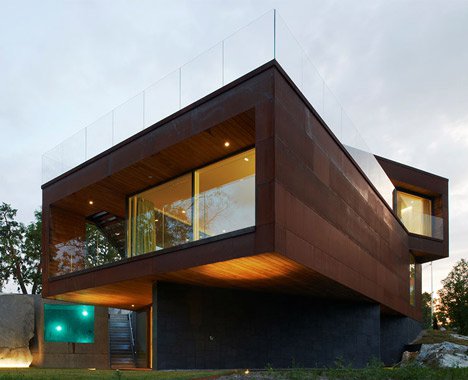
The rest of the home’s features are equally stunning and equally in tune with nature. The owners specified that their new home must have a master bedroom that bathes in morning light and a space from which they can sit and listen to the pouring rain, as well as an easy-care exterior.
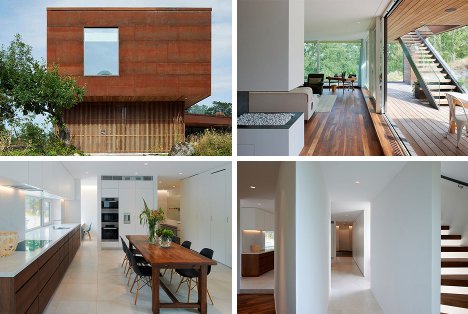
To comply with these requests, the architects created a concrete home clad in Corten steel. Other natural materials such as beech, walnut and marble are used throughout the home. The bulk of the home is split into two offset segments, maximizing the access to natural light and emphasizing the idea that the home is part of the natural landscape.
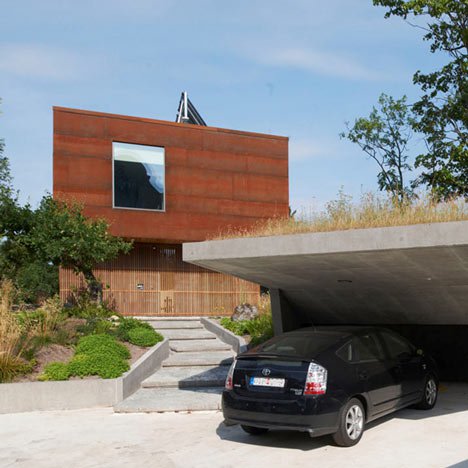
A carport has been blasted into the slope of the mountain on which the home sits. Its top is covered in vegetation, making it almost disappear into the land. The home’s tallest elevation and rooftop terrace also feature local grass, again visually reinforcing the home’s unity with its surroundings.





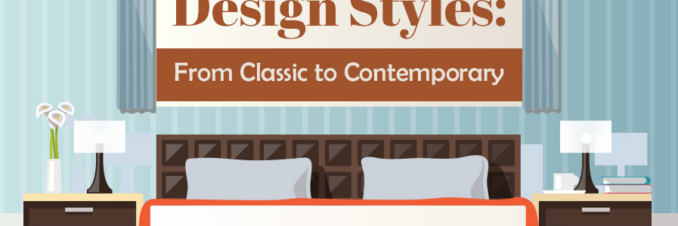





![A 44-Point SEO Checklist to Help Improve Your Process [Infographic]](http://www.emmanuelfonte.com/wp-content/uploads/2023/08/SEO-678x226.png)

